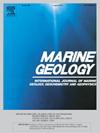The geomorphometry of Antarctic submarine canyons
IF 2.2
3区 地球科学
Q2 GEOSCIENCES, MULTIDISCIPLINARY
引用次数: 0
Abstract
Submarine canyons are deep, large-scale incisions found on most of the world's continental margins. In Antarctica, canyons are widespread features driving mesoscale oceanographic processes with significant implications for global climate and circulation, connecting shallow to deep sedimentary processes and positively influencing biodiversity and ecosystem functioning. The understanding of their oceanographic, climatic, geological and ecological significance is limited by the detail, accuracy and extent of canyon inventory. This study aims to create the best possible catalogue of Antarctic submarine canyons and gullies taking advantage of the new International Bathymetric Chart of the Southern Ocean (IBSCO) v.2. Semi-automatic hydrological techniques were adopted to delineate the drainage network, and to extract attributes such as the stream order, stream gradient and sinuosity. We identified 332 drainage networks with 3291 stream segments, nearly 5 times the number of canyons identified in previous studies, and calculated 15 morphometric parameters for each segment. We observe significant differences across Antarctic margins. East Antarctica shows the most complex and largest drainage networks, while the Antarctic Peninsula has the greatest number of networks, although with the lowest stream orders and shortest lengths. Western Antarctica has less complexity and shorter network lengths compared to East Antarctica. These differences may reflect the contrasting glacial histories of the two regions, with the earlier onset of the East Antarctic Ice Sheet leading to older and more developed canyon systems.
南极海底峡谷的地貌学
海底峡谷是在世界上大多数大陆边缘发现的深而大规模的切口。在南极洲,峡谷是驱动中尺度海洋学过程的普遍特征,对全球气候和环流具有重大影响,连接浅层和深层沉积过程,并对生物多样性和生态系统功能产生积极影响。对它们的海洋学、气候、地质和生态意义的认识受到峡谷清查的细节、准确性和范围的限制。这项研究的目的是利用新的国际南大洋测深图(IBSCO) v.2,创建南极海底峡谷和沟壑的最佳目录。采用半自动水文技术对流域水网进行圈定,提取流域序、坡度、弯度等属性。我们确定了332个流域网络,3291个河段,几乎是以前研究中确定的峡谷数量的5倍,并计算了每个河段的15个形态计量参数。我们观察到南极边缘的显著差异。东南极洲显示出最复杂和最大的水系网络,而南极半岛的水系网络数量最多,尽管其流阶最低,长度最短。与东南极洲相比,西南极洲的复杂性更低,网络长度更短。这些差异可能反映了两个地区不同的冰川历史,南极东部冰盖的早期形成导致了更古老和更发达的峡谷系统。
本文章由计算机程序翻译,如有差异,请以英文原文为准。
求助全文
约1分钟内获得全文
求助全文
来源期刊

Marine Geology
地学-地球科学综合
CiteScore
6.10
自引率
6.90%
发文量
175
审稿时长
21.9 weeks
期刊介绍:
Marine Geology is the premier international journal on marine geological processes in the broadest sense. We seek papers that are comprehensive, interdisciplinary and synthetic that will be lasting contributions to the field. Although most papers are based on regional studies, they must demonstrate new findings of international significance. We accept papers on subjects as diverse as seafloor hydrothermal systems, beach dynamics, early diagenesis, microbiological studies in sediments, palaeoclimate studies and geophysical studies of the seabed. We encourage papers that address emerging new fields, for example the influence of anthropogenic processes on coastal/marine geology and coastal/marine geoarchaeology. We insist that the papers are concerned with the marine realm and that they deal with geology: with rocks, sediments, and physical and chemical processes affecting them. Papers should address scientific hypotheses: highly descriptive data compilations or papers that deal only with marine management and risk assessment should be submitted to other journals. Papers on laboratory or modelling studies must demonstrate direct relevance to marine processes or deposits. The primary criteria for acceptance of papers is that the science is of high quality, novel, significant, and of broad international interest.
 求助内容:
求助内容: 应助结果提醒方式:
应助结果提醒方式:


